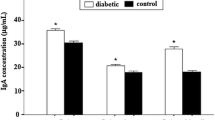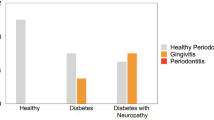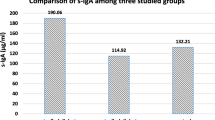Abstract
Diabetes mellitus, a complex metabolic disorder, is a syndrome characterised by abnormalities in carbohydrate, lipid, and protein metabolism. Type 2 diabetes mellitus accounts for approximately 95 % of all cases of diabetes, and it usually affects people aged over 45 years. Without a proper diagnosis, these individuals are at significant risk for life-threatening and oral complications like xerostomia, increased incidence of caries, infection, poor healing and periodontal disease owing to structural modifications of salivary glands. Salivary diagnosis is an increasingly important field in dentistry, endocrinology, immunology and forensic medicine as a number of drugs, hormones and antibodies can be reliably monitored in saliva, which is an easily obtainable, noninvasive diagnostic medium and salivary composition may correspond to the systemic state of the patient rather than the oral health. Thus, this study was undertaken to determine the quantitative and qualitative changes of saliva in type 2 diabetes mellitus patients and to correlate the oral manifestations with the salivary disturbances. The study consisted of two groups, one control and one study group, each with 50 subjects. Sialometry and sialochemistry of all salivary samples were carried out and oral manifestations recorded. The observations of the study were subjected to statistical analysis using SPSS software version 12. Sialometry showed a significantly lower salivary flow rate and higher occurrence of oral manifestations in the diabetics. From the clinical standpoint, it may be reasonable to conclude that sialometry and sialochemistry can be a useful indicator of progression of diabetes mellitus.
Similar content being viewed by others
References
Sherwin RS. Diabetes mellitus. In: Bennett JC, Cecil RL, Plum F, editors. Cecil Textbook of Medicine. Philadelphia: WB Saunders Co; 1996. p. 1258–60.
Raghupathy P, Belavendra A, Fall CHD, Geethanjali FS, Leary SD, et al. High prevalence of glucose intolerance even among young adults in south India. Diabetes Res Clin Pract. 2007;77:269–79.
Carda C, Mosquera-Lloreda N, Salom L, Gomez de Ferraris ME, Peydró A. Structural and functional salivary disorders in type 2 diabetic patients. Med Oral Patol Oral Cir Bucal. 2006;11:309–14.
Fox PC, Busch KA, Baum BJ. Subjective reports of xerostomia and objective measures of salivary gland performance. JADA. 1987;4:581–4.
Pai S, Ghezzi EM, Ship JA. Development of a visual analogue scale questionnaire for subjective assessment of salivary dysfunction. Oral Surg Oral Med Oral Pathol Oral Radiol Endo. 2001;91:311–6.
Manfredi M, McCullough MJ, Vescovi P, Al-Kaarawi ZM, Porter SR. Update on diabetes mellitus and related oral diseases. Oral Dis. 2004;10:187–200.
Löe H. Periodontal disease. The sixth complication of diabetes mellitus. Diabetes Care. 1993;16(2):329–34.
Porter SR, Scully C, Hegarty AM. An update of the etiology and management of xerostomia. Oral Surg Oral Med Oral Pathol Oral Radiol Endo. 2004;97:28–46.
Petrou-A C, Markopoulos AK, Belazi M, Karamitsos D, Papanayotou P. Prevalence of oral lichen planus in diabetes mellitus patients. Oral Dis. 1998;4:37–40.
Albrecht M, Banoczy J, Dinya E, Tamas G. Occurrence of oral leukoplakia and lichen planus in diabetes mellitus. J Oral Pathol Med. 1992;21:364–6.
Dodds MW, Dodds AP. Effects of glycemic control on saliva flow rates and protein composition in non-insulin-dependent diabetes mellitus. Oral Surg Oral Med Oral Pathol Oral Radiol Endo. 1997;83:465–70.
Sreenby LM, Yu A, Green A, Valdini A. Xerostomia in diabetes mellitus. Diabetes Care. 1992;15:900–4.
Lin CC, Sun SS, Kao A, Lee CC. Impaired salivary function in patients with noninsulin-dependent diabetes mellitus with xerostomia. J Diabetes Complications. 2002;16:176–9.
Mata AD, Marques D, Rocha S, Francisco H, Santos C, Mesquita MF, et al. Effects of diabetes mellitus on saliva. Mol Cell Biochem. 2004;261:137–42.
Acknowledgments
We would like to thank all the staff members of the Department of Oral Medicine and Radiology and the Dean of A. B. Shetty Memorial Institute of Dental Sciences, Mangalore.
Author information
Authors and Affiliations
Corresponding author
Rights and permissions
About this article
Cite this article
Kara, S.C., Nair, G.K. & Gogineni, S.B. Sialometry, sialochemistry and oral manifestations in type 2 diabetes mellitus patients—a clinical and biochemical study. Int J Diabetes Dev Ctries 35, 573–577 (2015). https://doi.org/10.1007/s13410-015-0347-7
Received:
Accepted:
Published:
Issue Date:
DOI: https://doi.org/10.1007/s13410-015-0347-7




